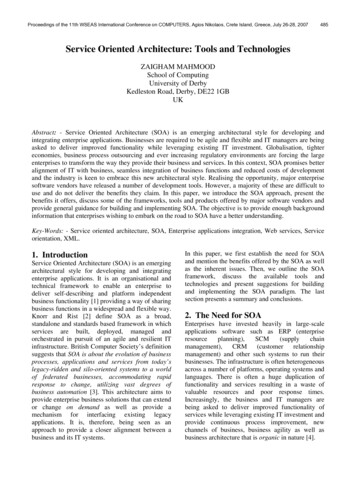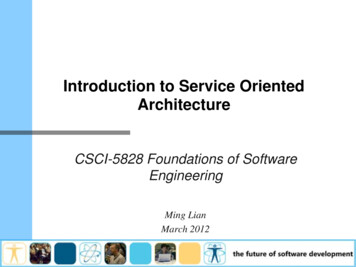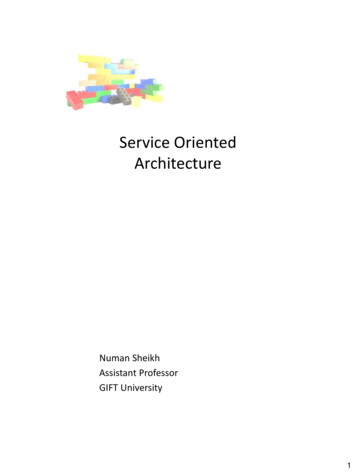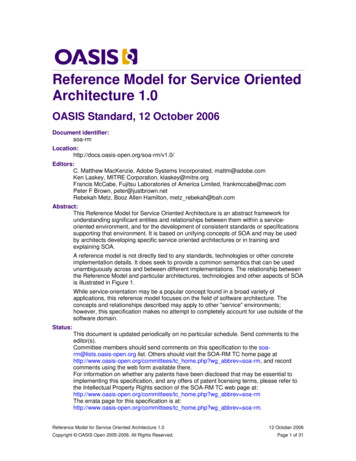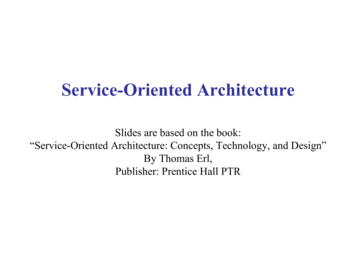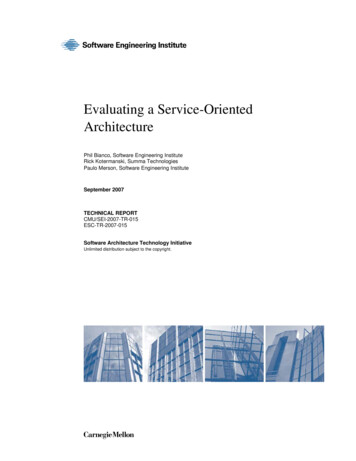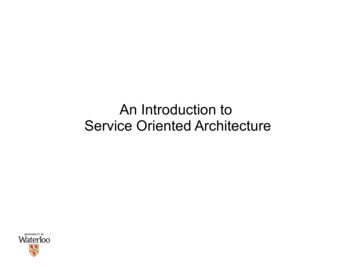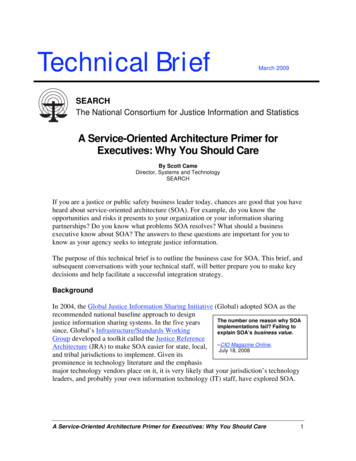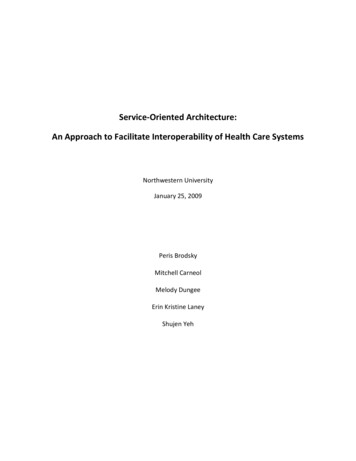
Transcription
Service-Oriented Architecture:An Approach to Facilitate Interoperability of Health Care SystemsNorthwestern UniversityJanuary 25, 2009Peris BrodskyMitchell CarneolMelody DungeeErin Kristine LaneyShujen Yeh
IntroductionHealth care practices and medical treatments are constantly evolving to meet the demands ofdiverse populations with complex disease processes. The Joint Commission for Accreditation ofHealth Care Organizations (JACHO) and other government regulatory agencies demandcompliance to national patient safety standards and protocols. In addition, the currenteconomy has forced health care and government leaders to take more fiscal accountability tomaximize resources. Health care organizations can strategically meet these requirements byestablishing interoperability as a best practice to improve patient outcomes. A service-orientedapproach to computer system architecture can facilitate the interoperability of health caresystems.Service-Oriented Architecture DefinedService-oriented architecture (SOA) is a strategy for organizing and managing computersoftware systems at the enterprise level. SOA enables an enterprise to select "best-of-breed"application functions without incurring the costs of integrating them that would otherwiseresult. With the standardization of behavior that SOA implies, applications acquired fromdifferent vendors and managed by different organizations can be plugged into an orchestra ofenterprise computing.SOA adopts two key architectural principles of individual system development and applies themto the entire spectrum of systems that an organization uses, including those controlled bybusiness partners. As such, SOA does not prescribe or reference any particular technologyplatform or implementation because the variety of platforms within most organizations isunlimited.The first key principle is modularity. This is the idea that a system should be decomposed intoseparate modules, each having a distinct, well-defined responsibility. Modularity encouragessoftware reuse to eliminate the redundant work of building and maintaining replicatedfunctions. (15)The second key principle is abstraction. A module X that uses the services of another module Ydoes so in an abstract way that avoids creating a specific dependency on Y. This is achieved byseparating interfaces from implementation. Module X is designed to use a standardized (blackbox) interface that Y implements. This allows a completely different module--call it Y'--to besubstituted for Y without requiring any changes to X.The abstraction principle is vital to much of application development. For example, the OpenDatabase Connectivity Standard (ODBC) interface was created to allow C language programs towork with different relational database products in a standard way. Before ODBC, a databaseapplication was either a Sybase application or an Oracle application for instance, and wouldneed to be completely rewritten to work with a different database.2
SOA Simply Explained"Architecture" suggests buildings and structure: bricks, mortar, steel, glass. Softwarearchitecture is more abstract. “Software architecture is the fundamental organization of asystem, embodied in its components, their relationships to each other and the environment,and the principles governing its design and evolution.” (12) One basic computer architecturemay include a browser which displays information, a server which processes information and adatabase which stores information."A service-oriented architecture is essentially a collection of services. These servicescommunicate with each other. The communication can involve either simple data passing or itcould involve two or more services coordinating some activity. Some means of connectingservices to each other is needed." (14) In the non-computer world, common services mayinclude subscriptions to services such as newspapers, cell phones or cable TV.In the healthcare industry, examples of services include lab and imaging results,pharmacy, medication management, ADT (admission, discharge, transfer) systems, medicaltranscription, storage of documents, and scheduling and billing services. All these services makeup a Health Information System (HIS). SOA is the integration of these different servicecomponents into an architecture that promotes the efficient delivery of medical care.Currently, many health care systems use independent vendors to provide these services in a“tightly-coupled” group of service components or modules. Tightly-coupled components arethose that are dependent on each other. "If you find a loose thread in a sweater and pull on it,you might find that the whole sweater is connected and dependent on that thread. When youpull it, the whole thing unravels." (11) This is tight-coupling. Now, if that same sweater wascreated with loose-coupling, it would have been made with separately knit components such assleeves, front, back and neck. Each component is then connected by a standard stitch. Now if athread unravels, only that one component will be affected leaving the others intact. Thatcomponent (sleeve) could then be replaced. This concept is the crux of understanding how SOAcan lead to greater integration. If the service modules (as noted above) are loosely-coupled,with standardized interfaces, the concept of a "plug-and-play" electronic health record (EHR)can be realized.What is meant by a standardized interface? Using the sweater analogy, assume that amongstknitters, there is an x-stitch which is considered a standard when attaching a sleeve. It is widelyaccepted because it is strong and durable. The x-stitch represents an interface connecting thesleeve to the body or core of the sweater. When connecting software modules to core pieces ofa hospital computer system, standardized software interfaces (like the sweater x-stitch) willallow loose-coupling. This loose-coupling allows a hospital system to shop around, find andthen select best-of-breed service modules that can be “plugged (stitched) in.” Advantages ofthis SOA model include flexibility to upgrade to new versions of software by replacing or addingmodular service components to meet new business or healthcare demands.3
Standards and SOAFor successful interoperation of any kind, the systems involved must be in prior agreementabout the methods and meaning of their communication. SOA does not eliminate thisrequirement for standards. In the end, an enterprise-wide ecosystem of standardized, serviceoriented applications is what affords an organization the flexibility to plug in the technologycomponents that best-suit its business needs. But in the end, standardization may be the mostdifficult SOA requirement to satisfy.At the lower end of the spectrum, many generic technology standards are already in place andin use. These are what enable the inter-networking that most systems rely on today. In supportof SOA, perhaps best-known is the W3C Web of Services (WS) standard, which defines a set oftechnology-agnostic standards based on the eXtensible Markup Language (XML). (16) This levelof standard covers service-oriented interoperation of systems from any application domain andis used in many industries. This level of standard is necessary, but not sufficient. Standardsmust be defined up to the application level. (7) Only then can independently-developedsystems be assured that they will interoperate correctly without modification.To this end, for clinical heath care, the Healthcare Services Specification Project (HSSP) wasstarted in 2005. (1) HSSP is a joint effort of Health Level Seven (HL7) and the ObjectManagement Group (OMG). (8, 5) Some of the standard specifications that HSSP has completedare:Entity Identification Service (EIS): a service for identifying clinical entities and theirattributes, especially patients, but also clinicians and organizations.Retrieve, Locate, Update Service (RLUS): a service to aggregate and modify entityinformation that may span multiple systems in multiple health care organizations, whichis essential to the creation of EHR systems.Decision Support Service (DSS): a service to assess known information about a patientand render decisions by applying medical system knowledge.Case StudiesIntermountain Healthcare SOAIntermountain Healthcare is nationally recognized for its ability to provide the best patient careoutcomes at the lowest possible cost. (13) In order to support this mission and vision,Intermountain has taken the lead in the implementation of electronic medical records that canbe accessed from all clinical settings since the 1980s. (3)4
Recently, Intermountain has partnered with General Electric (GE) Healthcare to create ECIS(Enterprise Clinical Information System), a suite of clinical applications that encompasses allaspects of patient care. (3, 4) In order to make this application fully accessible, Intermountain'svisionary leadership has organized the early adoption of SOA and the creation of one databaseto store all clinical information called the Clinical Database Repository.Intermountain's SOA utilizes an enterprise service bus (ESB) technology, which coordinates thetransfer of patient data to clinicians. (2) An ESB is one way of managing services in SOA and isbuilt on standards to allow flexible transport of messages across an information system. (9)ESBs allow data to travel between domain services and databases through a chosen application,such as from GE or another designated vendor.The following is a diagram by Dr. Stanley Huff, M.D., Chief Medical Informatics Officer atIntermountain Healthcare which illustrates the future infrastructure of Intermountain’s clinicalinformation systems using SOA. (4)Future State (simplified).NETECISDomainServiceOrdersWhite BoardProtocolsResults ReviewDischarge inServiceEnt Service rDomainServiceMiddlewareTierEnt Service BusDBServiceCCDR DBDBServiceDBServiceDBServiceData storageTierSOA for Clinical Decision Support in Nationwide Health Information Network (NHIN)The Clinical Decision Support for NHIN uses an SOA approach and is known as SANDS. (6) Thisapproach defines a standardized set of interfaces that “loosely-couples” decision supportservices. SANDS allows easy interchangeability of vendors. This is accomplished through theSOA principle of abstraction.Six use cases have been developed and tested using an EHR linked to the NHIN whichconnects Indianapolis, Mendocino, and Massachusetts. The use cases include druginteraction checking, syndrome surveillance, diagnostic decision support, inappropriate5
prescribing in older adults, information delivery at the point-of-care, and a simple personalhealth record. (6)The EHR prototype interfaces with the Isabel Diagnostic Decision Support System, GoogleCo-op (a free health search engine), UpToDate (a commercial source of evidencesummaries), Lexi-Comp (a drug interaction database), and Google Earth (for reportabledisease surveillance). Both UpToDate and Google Co-op were implemented for theinformation at the point-of-care use case, demonstrating the exchangeability of one modulefor another for a specific type of service. The modularity, flexibility, integration andinteroperability advantages of SOA are demonstrated by these use cases. (6)NYC Citywide Immunization Registry (CIR)The Citywide Immunization Registry (CIR) is a centralized repository of immunization recordslocated in New York City (NYC). Utilizing SOA and vendor specific EHRs (EPIC, Cerner, etc.),healthcare providers are able to access these records and use this information to ensure that allrecommended immunizations are given. (10)SummaryIn a service-oriented architecture, "services can be shared and reused across several businessprocesses. The result is a highly adaptive environment, with lower costs for applicationdevelopment, improved integration and quicker deployments." (2) The above case studies areexamples of how a service-oriented architecture facilitates the interoperability and integrationof health care information systems. SOAs may be implemented in several ways. IntermountainHealthcare uses EBS technology to streamline the flow of data and to provide the flexibility toreplace applications as needed. This "plug-and-play" concept provides an efficient system todeal with future growth and expansion. The CIRS and NHIN examples demonstrate theincorporation of web-based SOA which is used to help disparate health care systems integrateand provide decision support at the point-of-care. Once interoperability through SOA isestablished, it is believed this will contribute to improved patient outcomes and lower healthcare costs. It is recommended that health care organizations consider using a service-orientedarchitecture to facilitate interoperability.6
References1. The Practical Guide to SOA in Healthcare: Healthcare Services Specification Project (web).Retrieved January, 24, 2010, from http://hssp.wikispaces.com/.2. IBM Global Technology Services. (2008, January). How Service-Oriented Architecture (SOA)Impacts Your IT Infrastructure: Satisfying the demands of dynamic business processes.Message posted to ameset.jsp?tab id 2 1&url e%3dCourse%26id%3d 248577 1%26url%3d.3. Shortliffe, Edward H., Cimino, James J. (2006). Biomedical Informatics: ComputerApplications in Health Care and Biomedicine, (3rd edition).4. Impact of SOA Initiatives on Business-IT Alignment and Business Agility (web). RetrievedJanuary 24, 2010, from /1505 Huff.pdf.5. Object Management Group (web). Retrieved January 24, 2010, from http://www.omg.org.6. Wright, A., Sittig, D. F. SANDS: A Service-Oriented Architecture for Clinical Decision Supportin a National Health Information Network. Journal Biomedical Informatics, 41 (2008), 962981.7. Panko, Raymond R. (2007). Business Data Networks and Telecommunications, (6th edition).8. Health Level 7 (web). Retrieved January 24, 2010, from http://www.hl7.org.9. Enterprise Service Bus (web). Retrieved January 24, 2010, from http://en/wikipedia.org/wiki/Enterprise service bus.10. New York City Citywide Immunization Registry (CIR) HL7 Web Service (web). RetrievedJanuary 24, 2010, from http://www.nyc.gov/html/doh/html/cir/.11. Hurwitz, J., Bloor, R., Baroudi, C., Kaufman, M. (2007). Service Oriented Architecture forDummies.12. Architecture definitions (web). Retrieved January 25, 2010, from 3. Intermountain Healthcare (web). Retrieved January 24, 2010, from http://www.ihc.net.14. SOA Defined (web). Retrieved January 24, 2010, from rticles/service-oriented architecture soa definition.html.15. Service-oriented architecture (web). Retrieved January 25, 2010, from http://en.wikipedia.org/wiki/Service-oriented architecture.16. W3C (web). Retrieved January 25, 2010, from http://www.w3c.org.7
Service-oriented architecture (SOA) is a strategy for organizing and managing computer software systems at the enterprise level. SOA enables an enterprise to select "best-of-breed" application functions without incurring the costs of integrating them that would otherwise

